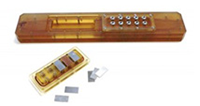Biomedical Biofilm Devices
Bacteria are classified as planktonic (free floating) or sessile (anchored). In medicine, bacterial infections were traditionally considered to be planktonic, and antibiotics were developed with this in mind – it is relatively simple to kill planktonic bacteria. Bronchitis, for example, can be treated quickly and effectively with a course of antibiotics without harming the patient. But many infections are caused by sessile bacteria that form biofilms. An example of this is tuberculosis, in which biofilms of Mycobacterium tuberculosis infect the alveolar surfaces of the lung. Such organized biofilms harbor drug-tolerant cells and are notoriously hard to cure, requiring months or even years of treatment that can be as gruelling for the patient as it is for the infection.
Biofilms are capable of colonizing virtually any surface on earth and they are extremely difficult to kill. In medicine, biofilms can be found adhering to surfaces in most aqueous environments, such as teeth, contact lenses, catheters, surgical tools and surgical implants.
Tyler Research produces a series of standard devices for the growth and analysis of biofilms in biomedical applications. These range from low pressure laboratory-scale devices to medium- and high-pressure devices suitable for in-line monitoring of pressurized systems. Many of these are featured in the pages that follow, but we recognize that it may be necessary to design a biofilm device from first principles to meet the needs of a specific application. This is an integral part of what we do.
The design of a successful biofilm system is dependent upon many factors, and we recommend that you contact us with your application so that we can work with you to develop the system most appropriate for your needs. Considerations such as pressure, flow rates, flow characteristics, anticipated temperature range, chemical resistance, sterilization procedures, biostud configuration, sampling frequency and space constraints, to name a few, will have a major impact on manifold design and performance.


